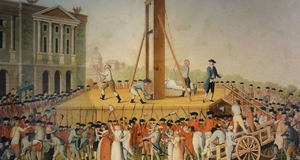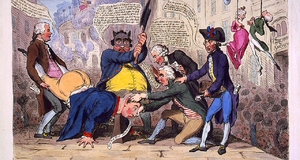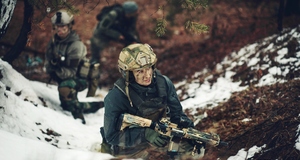Napoleon Bonaparte's Peak of Military Success: Ulm and Austerlitz
By
2012, Vol. 4 No. 09 | pg. 2/2 | « Napoleon was successful on the battlefield because he successfully utilized the weapons and technology of the Era that helped formulate his strategy and tactics.16 Technology during the “Napoleonic Era” was relatively unchanged. For the infantry, their small arms, such as the musket and bayonets, changed very little. However, the artillery arms went through some major changes during Napoleon’s rise to power. Artillery pieces were now made with interchangeable parts, which were suitable for mass production; gun carriages were built to a standard model; the mobility of the guns were improved by harnessing the horses in pairs instead of in file; hardwood axles replaced heavy iron ones; and accuracy was improved through the introduction of the "tangent sight," which is a graduated brass measure that enabled the gunner to sight the gun on a target. The greater mobility of the artillery would be one of the most defining improvements, since it would make it possible for the guns to accompany divisions.17 Napoleon essentially mastered Europe with the weapons and equipment he had available. Napoleon also improved on the use of divisional formations. Through the use of divisional formations, Napoleon revolutionized strategy. Armies now composed of detachable parts that could engage the enemy alone until the rest of the army came up in support.18 These divisions could be used in encircling or flanking movements, while on the defensive the division could be used to prevent offensive maneuvers. This type of formation could now take the advantage of parallel roads and be able to concentrate immediately before making initial contact with the enemy. As a result of implementing divisional formations, generalship was made more complicated and staff work became very important, as well as the need for highly detailed maps that would need to show terrain features and road networks. It was through this type of generalship, that Napoleon would demonstrate his genius, since he was essentially his own chief of staff and was able to effectively direct operations of his armies, were others would have failed.19 Although Napoleon implemented the use of divisional formations, these armies during the Napoleonic Wars would drastically increase in size due to conscription. In order to effectively command large number of troops, Napoleon would implement permanent army corps within the French army. This organizational unit became essential for administration and command when controlling these large numbers of troops. The corps formation would be utilized as the division: a combined arms organization composed of infantry, artillery and cavalry. The cavalry would be responsible for conducting reconnaissance for the entire corps and would also have its own divisional organization within the corps.Even though the corps made it easier for Napoleon to direct his forces, the division would still remain as the major tactical unit within the French army.20 To make effective use of his army's superior mobility and inspiration, Napoleon developed two major strategic systems. When he was facing an enemy superior in numbers, the strategy of the central position was used in order to split the enemy into separate parts. This was where each could be eliminated in detail through maneuvering in order to gain the French a local superiority of force in successive actions by bringing the reserve into action at the critical time and place. On the other hand, when the French held superiority in numbers Napoleon would use a maneuver of envelopment. By using this tactic, Napoleon would capture his foe's attention with a detachment of his army while the bulk of his army would sweep against the enemy's lines of communication in order to sever the enemy's links with his bases.21 By employing these two unique strategies, Napoleon always looked for way’s he could draw his enemy out to battle. He saw battle as a means to destroying his enemy's means of resistance. Napoleon's first defined objective at the outset of any of his military campaigns was the enemy's army, which he intended to destroy. If his enemy did not want to risk going into battle, he would simply force them into battle through his maneuvering. Throughout all of his military campaigns, Napoleon always sought to seize and retain the initiative, in order to impose his will upon the enemy. Even when Napoleon was extremely outnumbered, he was still able to out-smart his enemies through marching and maneuvering, in order to employ the bulk of his forces at a weakened point of the enemy's line. It was through Napoleon's focus on the enemy's armed forces and his ability to exercise quick maneuvering that he would enjoy most of his successes.22 The core of Napoleon’s army was his infantry men, who individually could expect two to three weeks of basic training, which stressed the use of the bayonet. The Napoleonic foot soldiers were renowned for their agility, stubborn attacks, as well as the speed of their marches. This speed and maneuverability formed the foundation of Napoleon's successful campaigns, and was made possible by, the lack of baggage that was carried by the French foot soldier, since they lived off the land. Even-though Napoleon believed that while infantry was the main arm of an army, it could not stand up to superior artillery. He would borrow his ideas in employing artillery from Chevalier du Teil, who was Napoleon's superior in command of artillery at Toulon, where he had urged that artillery be concentrated at the point of attack and dispersed along the entire line. Napoleon would follow this practice and would use his large caliber guns to blast a hole in the enemy's line into which the infantry could penetrate. As time went on, and the quality of French conscripts deteriorated, Napoleon would increase the proportion of artillery in his armies and he would rely more and more on bombardment in battle.23 During the era of Napoleon, no one was able to match his ability to use weapons, technology, and tactics. Napoleon was not much of an inventor of military tactics, but rather a borrower from his teachers and what he experienced on the field of battle. Napoleon applied much of what he learned, reflected, and added his own twist to military tactics, which provided the foundation for his string of successes on the European continent. Overall, the impact on the European continent would be through the emergence of the "nation-in-arms," which demonstrated the ability to field masses of troops and dramatically increased production efforts with a nation behind the war effort. It would be the combination of Napoleon's war reforms and the French nation behind his forces in the field that would have the greatest resounding impact on Europe.24 Endnotes 1.) For more information on Napoleon’s previous Military Campaigns before Austerlitz, refer to Alistair Horne, Napoleon: Master of Europe 1805-1807(New York: William Morrow and Company, Inc., 1979), p.9-102 2.) http://www.theartofbattle.com/ulm-campaign-1805.htm(accessed 4/2/12) 3.) Ibid.,(accessed 4/2/12) 4.) Alistair Horne, Napoleon: Master of Europe 1805-1807(New York: William Morrow and Company, Inc., 1979), p.111 5.) Ibid., p 116 6.) Ibid., p. 116 7.) Ibid., p.115. 8.) Ibid., p.130. 9.) http://militaryhistory.about.com/od/napoleonicwars/p/austerlitz.htm(accessed 4/3/12) 10.) Ibid.,( accessed 4/3/12) 11.) Alistair Horne, Napoleon: Master of Europe 1805-1807(p. 160. 12.) [12] http://militaryhistory.about.com/od/napoleonicwars/p/austerlitz.htm(accessed 4/3/12) 13.) http://www.answers.com/topic/napoleon-s-speech-at-austerlitz (accessed 4/16/12) 14.) Ibid(accessed 4/3/12) 15.) Alistair Horne, Napoleon: Master of Europe 1805-1807(p.170. 16.) http://www.militaryhistoryonline.com/18thcentury/articles/thesuccessofnapoleon.aspx (accessed 4/16/12) 17.) Ibid(accessed 4/15/12) 18.) Ibid(accessed 4/15/12) 19.) Ibid(accessed 4/15/12) 20.) Ibid(accessed 4/15/12) 21.) Ibid(accessed 4/15/12) 22.) Ibid(accessed 4/15/12) 23.) Ibid(accessed 4/15/12) 24.) Ibid(accessed 4/16/12) Works Consulted Books: Anderson, J. H. The Napoleonic Campaign of 1805. London: 1912. Burton, Lt. Col. R. G. From Boulogne to Austerlitz. London: 1912 Carr, Edward. From Napoleon to Stalin and other essays. New York: St. Martin’s Press, 1980. Chandler, D. G. The Campaigns of Napoleon. London: 1967. Duffy, Christopher. Austerlitz, 1805. London: 1977. Durant, Ariel and Will. The Age of Napoleon: A History of European Civilization from 1789 to 1815. New York: Simon and Schuster, 1975. Geyl, Pieter. Napoleon: For and Against. London: Bradford and Dickens, 1945,1957. Holtman, Robert. The Napoleonic Revolution. New York: J.B Lippincott Company. 1967. Horne, Alistair. Napoleon Master of Europe, 1805-1807. New York: William Morrow and Company, Inc. 1979. Lachouque, Comdt. Henry. Napoleon a Austerlitz. Paris: 1960. Lachouque, Henry and Brown, Anne S.K. The Anatomy of Glory: Napoleon and his Guard. London: 1961. Mahan, Admiral A.T. Influence of Sea Power upon the French Revolution and Empire. London: 1892. North, Jonathan. The Napoleon Options: Alternate Decisions of the Napoleonic Wars. PA, USA: Stackpole Books. 2000. Rogers, Col. H.C.B. Napoleon’s Army. London: 1974 Rothenberg, G. E. The Art of Warfare in the Age of Napoleon. London: 1977. Rude, George. Revolutionary Europe, 1783-1815. London: 1967. Weber, Eugene. Peasants into Frenchmen. The Modernisation of Rural France, 1870-1914. London: 1944. Yorck von Wartenburg, Gen. Napoleon as a General. London: 1902. Young, Peter. Napoleon’s Marshals. London: 1973 Journals: Bertuad –Paul, Jean “ Napoleon’s Officers,” Past and Present, no. 112 (August., 1986):91-111 http://www.jstor.org/stable/650999 (accessed February 16, 2012) Brown, Valerie “ Napoleon and General Dumas,” The Journal of Negro History 61, no. 2 (April., 1976): 188-199 http://www.jstor.org/stable/2717270 (accessed February 16, 2012) Hardy, Dixon. P. “Napoleon Bonaparte,” The Dublin Penny Journal 3, no. 154 ( June 13, 1835): 393-94 http://www.jstor.org/stable/30003253 (accessed February 17, 2012) Peyre, Henri. “Napoleon: Devil, Poet, Saint,” Yale French Studies 26, The Myth of Napoleon (1960): 21-31 http://www.jstor.org/stable/2929219 (accessed February 16, 2012) Videos: FMD. “An Age of Revolutions: Rise of Napoleon Bonaparte,” Films on demand Web site. http://sholto.chowan.edu:2048/login?url=http://digital.films.com/PortalPlaylists.aspx?aid=7640&xtid=7051&loid=10186 (accessed February 16, 2012) FMD. “ An Age of Revolutions: Napoleon’s Army in Russia.” Films on demand Web site. http://sholto.chowan.edu:2048/login?url=http://digital.films.com/PortalPlaylists.aspx?aid=7640&xtid=7051&loid=10187 (accessed February 17, 2012) Websites: Peter J. Dean, Research Subjects: Napoleon Himself, Napoleon as a Military Commander: Limitations of a Genius, http://www.napoleon-series.org/research/napoleon/c_genius.html (accessed February 17, 2012) Cadet W. Beron, Military Subjects: Organization, Strategy & Tatics:"Heads Up, By God!" French Cavalry At Eylau, 1807 And Napoleon's Cavalry Doctrine, http://www.napoleon-series.org/military/organization/c_eylau.html (accessed February 17, 2012) Tony Brouhgton, Military Subjects: Organization, Strategy & Tactics: Regiments d'Artillerie de Marine and the Colonels who led them during the Period 1803 – 1815. http://www.napoleon-series.org/military/organization/c_artyofficers2.html (accessed February 17, 2012) Kenndey Hickman, Napoleonic Wars: Battle of Austerlitz. http://militaryhistory.about.com/od/napoleonicwars/p/austerlitz.htm(accessed April 3, 2012) Richard Podruchny: The Success of Napoleon, http://www.militaryhistoryonline.com/18thcentury/articles/thesuccessofnapoleon.aspx (accessed April 15, 2012) Suggested Reading from Inquiries Journal
Inquiries Journal provides undergraduate and graduate students around the world a platform for the wide dissemination of academic work over a range of core disciplines. Representing the work of students from hundreds of institutions around the globe, Inquiries Journal's large database of academic articles is completely free. Learn more | Blog | Submit Latest in History |
















